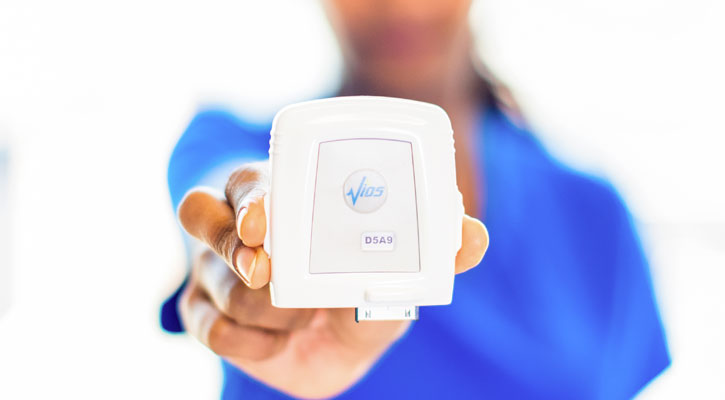
How to Integrate the Vios Monitoring System Into Your Healthcare Setting
The Vios Monitoring System (VMS) is a wireless, FDA-cleared, internet of things (IoT) patient monitoring solution designed to improve patient outcomes and reduce costs. The VMS enables clinicians to continuously monitor a patient’s 7-lead ECG, heart rate, respiratory rate, pulse rate, SpO2 and posture. It also accommodates the manual entry and input of blood pressure and body temperature data. Healthcare facilities are able to leverage their existing IT infrastructures and deploy the solution throughout their various care settings.
Before a healthcare provider can benefit from using a Vios wearable vital signs monitor, it needs to be integrated into their hospital or healthcare setting. To accomplish this, Vios has mapped out a three-phase plan that accounts for all the details, stakeholders and necessities for successful deployment.
As would be expected, each deployment is somewhat unique and therefore requires different amounts of time to complete.
The three phases consist of planning, coordination and delivery. However, before the phases begin, we also suggest a pre-deployment checklist to make sure everything is aligned.
The checklist includes:
- Review and understand deployment phases
- Confirm the scope of work
- Check IT infrastructure for compatibility
- Identify and inform internal stakeholders and assets
- Verify potential scheduling needs or conflicts
Vios Integration Phase One: Planning
Much of phase one of the Vios Monitoring System integration is assigning, documenting and confirming functional details that create the foundation of the vital signs monitoring system deployment.
On the client-side, key roles will include the project lead, vendor management and IT project team. On the Vios side of the equation, there will be the key roles of project lead, field support engineer and clinical operations.
The tasks for phase one include:
- The scope of work is signed.
- Billing and shipping details are collected.
- A system assembly work order is created.
- A work order is delivered to manufacturing.
Vios Integration Phase Two: Coordination
In many ways, phase two is when the integration project comes to life for most stakeholders. This is the time it goes from a conceptual idea to real-world planning and coordination of team members. As such, the number of stakeholders involved and the number of interactions increases. The key roles for phase two on the client-side include the project manager, IT project owner, clinical lead, executive lead, HIPAA security, and IT/security project team. On the Vios side, there will be the project lead, field support engineer and clinical operations.
The tasks for phase two include:
- Internal and external kickoff.
- Schedule meetings, delivery, deployment timeline and establish go-live date.
- Manage internal/external stakeholder communications.
- Coordination with IT for software integration.
Vios Integration Phase Three: Delivery
Phase three is when the Vios Monitoring System makes its first appearance on-site at the healthcare facility and all the planning begins to pay off. From here, we can see the finish line and the opportunity to improve patient care is just ahead. Key roles on the client-side will encompass biomedical engineers, the IT team, the project manager and vendor management for acceptance. Vios roles for phase three are technical operations specialist and clinical operations.
The tasks for phase three include:
- Confirm technical task punch list is complete.
- Coordinate delivery of the Vios Monitoring System.
- On-site install and setup.
- Coordinate departments for on-site go-live.
When Is It Time to Train Your Clinicians?
You may have noticed we haven’t mentioned training yet. Don’t worry, training is accounted for, too. It’s just not part of the integration timeline.
The Vios Monitoring System does work differently than traditional physiologic monitoring systems. Training typically happens during week six and requires three to four days to complete. This includes nurse training and competencies as well as technician and superuser classes.
Learning to use and feel comfortable with the Vios Monitoring System is fast and easy. Once clinicians realize all the benefits, they become eager to master using it.
There are also one to two weeks of ongoing support after the go-live date to further assist in using the Vios Monitoring System.
You’re Not Far From Improved Patient Care
The Vios Monitoring System allows your clinicians to have more comprehensive and timely data on a patient’s status. This helps them make each patient interaction intentional and beneficial. And typically, you can implement the Vios Monitoring System in a matter of months. That’s a rapid road to greatly improved care options. Connect with Vios and find out how your facility can bring the power of the Vios Monitoring System to its care units and see just how soon integration can begin.
We’re ready to help you improve patient care.
